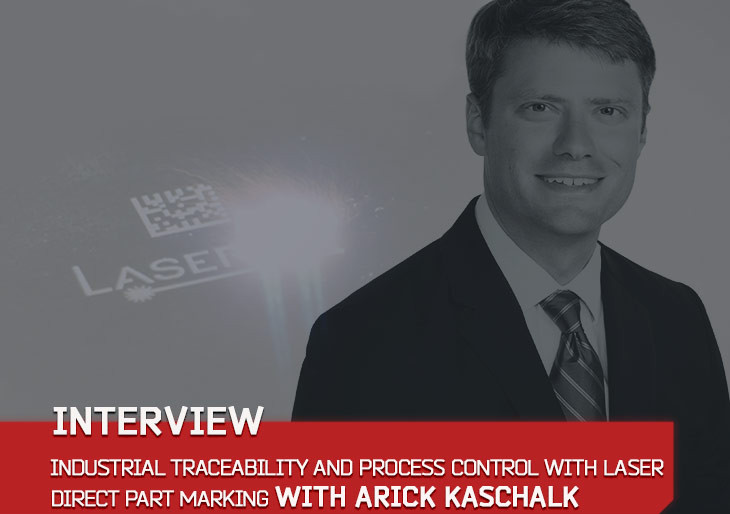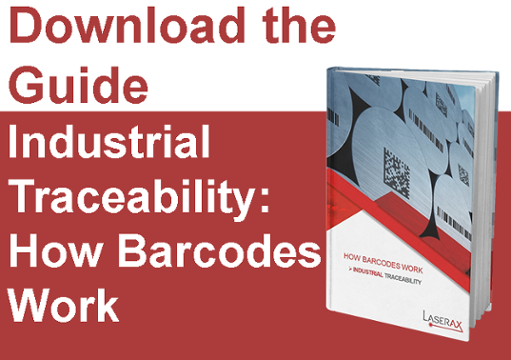Automotive Part Marking Technologies - Which One to Choose?
If you are struggling to find a marking method for traceability, or simply for process improvement, you are not the only one.

Hear what Arick Kaschalk from Visi-Trak, a leading provider of monitoring and control solutions to the die casting industry, has to say about the burning subjects of the hour for diecasters: traceability, process control and laser marking. Have a listen.
Martin Hartlieb and Arick Kaschalk, Sales manager at Visi-Trak discuss the arguments in favour of improved traceability, the benefits associated with laser marking, such as improved process control, the advantages of laser marking over other direct part marking technologies and what the future holds for traceability and process control in the die-casting and automotive industry.
Martin Hartlieb: Visi-Trak is one of the leading companies - it is world-wide, of course especially in North America - for anything regarding to sensing, monitoring and controlling of the die-casting process. So, Arick, could you present yourself?
Arick Kaschalk: Sure, thank you Martin, I appreciate the introduction there. See, Visi-Trak is focused on die-casting and for all the same technologies that you mentioned in terms of monitoring and control within die-cast cell. A lot of casters come to us when they are looking for waste reduction and increase in productivity and efficiency and we have a number of technologies that we can implement into the die-casting process to help improve along those lines.
Martin Hartlieb: Yes, exactly! Perfect. So, why did you see your customers - the die-casters - opting for traceability and what arguments led them to the conclusion they will need to put a better traceability system in place.
Arick Kaschalk: Sure! I mean, one of the biggest reasons is that the end customers, the OEMs, the automotive parts manufacturers required it. They made the determination that they wanted to have serialization on their parts and to have that serial number relate back to process data under which the part was manufactured. And having a traceability system in place was the best way to accomplish that. In order to get the business for the OEMs they have to implement traceability. Some casters have opted for that just as a minimum requirement but once they saw the benefit that they can get, once they have a traceability system in place, such as the statistical analysis and process improvement, they started to implement on more than just the parts that the OEMs were requiring.
Martin Hartlieb: Interesting! So, what exactly does it mean to include traceability in specifically the die-casting supply chain and what have been the issues to address and overcome until now, in your opinion?
Arick Kaschalk: One of the first things people think of when they think of traceability is they look at the casting and they see this serial number stamped on it. Having that mark legible and able to withstand up through auxiliary processing of the part and through the lifecycle of the vehicle, They want to make sure that the marking is going to last!
Martin Hartlieb: Yes, that is a great point! And I know or I have seen in other processes inkjet printers or just labels are being used and certainly in the die-casting industry, you could not use that. Not if you want the marking to survive the whole vehicle life. Have you gained experience with different marking technologies through customer feedback?
Arick Kaschalk: Oh sure, there’s two of the primary technologies that we see in casting, there are pin and laser marking. One of the original, when we started the traceability systems going, it was a pin stamper. Pin stampers had a bit of a longer cycle time and legibility was part of the challenge.
Usually, what makes a traceability code is a string of digits that could be anywhere from ten to twenty or maybe even upward of twenty characters. You can represent that in a human readable code where you and I just look at that and understand it, and there’s also a 2D matrix that would be the size of the stamp and basically relate the same information just in a 2D matrix format.
Now, when you do that 2D matrix, there’s a scanner that has to be able to read that and the more characters you have in that, the more complex that 2D matrix gets, and a lot of pin stampers just can’t keep up when it gets to that complexity. So this has been a big advantage to the casters to have the laser marking system in terms of being able to recognize what that marking on the casting means.
Martin Hartlieb: Yes. So would you say that laser marking is really the choice because of cycle time - especially with more complex and larger markings - and because of much better readability that lasts longer. Is that what you see in the market?
Arick Kaschalk: Yes. Those are two very critical concerns in the die-casting process. So absolutely: legibility and cycle time are two of the most important considerations.

Martin Hartlieb: Do you see other things like... I think I have heard that with the pin markers you really have to put the casting in a specific place and it sometimes can get tricky if the surface is more uneven things like that... is that important for you as well?
Arick Kaschalk: Yes, definitely! We see the advantage of being able to just have a robot pick the part straight out of the casting machine and present it to the laser marker. It gets marked and, you know, in a matter of a second or seconds... or several seconds... it is on to the next process within the casting cell.
Martin Hartlieb: Okay, super! Thank you! Final question: how do you see traceability in five or in ten years? Especially in the die-casting industry.
Arick Kaschalk: One of the things we have seen with a lot of our customers when they implement traceability, they’ve also implemented a process improvement project along with implementing traceability. They’ve been adding the serial number onto the part as a requirement to meet their customer’s specifications. But, once you have that mark on there, you are going to have some fall out and parts that do not meet specifications or need to be scraped.
And you can take those items that don’t pass quality tests and begin to group and analyze all the data under which the part was manufactured. This really allows you to own your process and improve the efficiency within your casting process.
It allows you to recognize what are the drivers of scrap and inefficiencies within the process. So, while we’re seeing the traceability as a requirement in a small percentage of parts, once people are realizing the benefits of implementing the systems and the improvements and efficiency gains that they can implement once they begin analyzing all this data, we’re going to see a higher percentage of product having traceability.
Martin Hartlieb: Okay. Well, very interesting. So, thank you very much, Arick, and thanks everybody for listening in and I hope to hear you again in our next interview. Goodbye!
Arick Kaschalk: Thanks so much, Martin.
We have learned that diecasters are often forced into improving their traceability systems by their customers in the automotive industry. Part serialization is a common requirement for OEMs.
This kind of part to part traceability can be achieved with dot peen and laser marking systems as well as others, such as labeling or inkjet printer. Laser marking technology has many advantages over its competitors. It is faster, provides better contrasts, and its markings are more rugged and durable. An adequate laser mark can withstand most post process treatments, including shot blasting. That’s clearly out of the question for labels, dot peen marking and inkjet printing. When dealing with rough surfaces, dot peen marking is hardly an option.
Once traceability enters in a plant, it becomes very easy to analyse the wealth of data that it provides. It can be used to improve and gain control over processes and troubleshoot quality problems that are bound to arise when new quality requirements are added.

This webcast is brought to you by Laserax, a laser systems manufacturer dedicated to providing efficient, innovative and safe solutions for the most demanding industrial applications.
Should you want to learn more about laser Direct Part Marking, Data Matrix Codes or traceability, get in touch with our laser technology experts.
Visi-Trak introduced advanced process monitoring and shot control to the die casting industry almost 40 years ago. Since that time we have never stopped working to help you advance your process and increase your profits. Through a suite of technologies designed to work with nearly any manufacturer’s machine, Visi-Trak gives you an accurate, consistent, and instant view of your operation.
Viami International Inc. is specialized in the aluminum industry, offering services to metal/alloy producers, processors, equipment/technology providers and R&D centres. These services include technical and commercial training, consulting and support in sourcing, marketing and process improvement, as well as development of new (mostly international) business/markets.